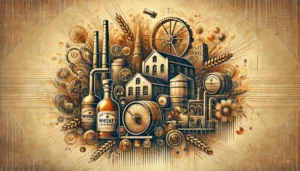Introduction to Irish Whiskey Tasting
Irish whiskey, a liquid tapestry woven with history and flavour, has captured the hearts of spirits enthusiasts worldwide. In “Savour the Spirit: A Beginner’s Guide to Irish Whiskey Tasting,” we embark on a journey through the emerald isles of Ireland, exploring the enchanting world of one of the globe’s most beloved whiskeys. This guide is tailored for those new to the whiskey tasting scene, offering a comprehensive yet accessible entry into a realm rich with tradition and taste.
As we delve into the intricacies of Irish whiskey, we’ll uncover the fundamentals that make this spirit unique. From the rolling green hills where its ingredients are sourced to the centuries-old distilleries where magic happens, Irish whiskey is a story in every sip. We’ll decode the essential terminology, guiding you through the language of whiskey tasting, and equip you with techniques to taste like a pro. By identifying the symphony of flavours and aromas, you’ll learn to appreciate the subtleties and complexities that Irish whiskey offers.
Whether you’re a curious newcomer or a seasoned drinker looking to expand your horizons, this guide promises to enhance your understanding and enjoyment of Irish whiskey. So, pour yourself a dram, sit back, and let us begin our journey into the heart of Irish whiskey tasting.
Irish Whiskey 101 – Understanding the Basics
Irish whiskey, known for its smoothness and distinctive character, is a world-renowned spirit that has been perfected over centuries. As we begin our journey into Irish whiskey tasting, it’s essential to lay the foundation by understanding what Irish whiskey is and what makes it stand out from other types of whiskey.

1. What is Irish Whiskey?
Irish whiskey is a type of whiskey that is exclusively produced in Ireland. It is known for its smoothness and often has a lighter and fruitier profile compared to its Scottish and American counterparts. The production of Irish whiskey follows strict regulations regarding its ingredients, distillation, and aging. It must be distilled and aged in Ireland, with aging taking place for a minimum of three years in wooden casks.
2. Key Characteristics of Irish Whiskey
One of the key characteristics of Irish whiskey is its triple distillation process, although not all Irish whiskeys are triple distilled. This additional distillation step typically results in a smoother and lighter spirit. The use of unmalted barley in the mash bill, alongside malted barley, is another unique feature of many Irish whiskeys. This combination contributes to the whiskey’s distinct flavour profile.
3. The Flavour Profile
Irish whiskey typically offers a balance of sweet and fruity notes, with flavours ranging from vanilla, honey, and caramel to apple, pear, and citrus. Some whiskeys may also have hints of spice, nuts, or chocolate. The flavour profile can vary greatly depending on factors such as the type of grain used, the distillation process, and the aging conditions.
4. Types of Irish Whiskey
There are several types of Irish whiskey, including single malt, single pot still, single grain, and blended whiskey. Each type offers a different taste experience:
- Single Malt Irish Whiskey: Made from 100% malted barley and distilled in pot stills at a single distillery.
- Single Pot Still Irish Whiskey: A traditional Irish style, made from a mix of malted and unmalted barley, distilled in pot stills.
- Single Grain Irish Whiskey: Made from a variety of grains, typically in a column still, offering a lighter and smoother taste.
- Blended Irish Whiskey: A blend of different types of whiskeys, often combining the flavours of single malt and grain whiskeys.
5. The Aging Process
The aging process significantly influences the flavour of Irish whiskey. The type of wood used in the casks (often oak), previous contents of the casks (such as sherry, bourbon, or wine), and the length of aging all play crucial roles in developing the whiskey’s final flavour profile.
Decoding Whiskey Terminology – Grasping the Language of Tasting
Understanding the language of whiskey tasting is crucial for anyone looking to deepen their appreciation of Irish whiskey. This section will demystify key terms and concepts, helping beginners to confidently navigate the world of whiskey tasting.

1. Common Whiskey Terms
- Nose/Tasting Notes: Refers to the aroma or scent of the whiskey. ‘Nosing’ is the act of smelling whiskey to identify its various fragrances.
- Palate: Describes the flavours perceived in the mouth when tasting whiskey.
- Finish: The aftertaste that lingers in the mouth after swallowing the whiskey. It can be short, medium, or long and varies in flavour intensity.
- Single Malt: Whiskey made from 100% malted barley at a single distillery.
- Blends: A mix of different types of whiskeys, often from various distilleries.
- Pot Still: A traditional method of distillation used in Irish whiskey making, often contributing to a fuller, richer flavour.
2. The Importance of Aroma
Aroma plays a critical role in the tasting experience, as much of what we perceive as flavour comes from our sense of smell. Terms like ‘fruity’, ‘peaty’, ‘spicy’, and ‘woody’ are often used to describe the aroma of whiskey.
3. Flavour Profile Descriptions
When tasting whiskey, enthusiasts often refer to a range of flavour notes, such as:
- Sweet: Vanilla, caramel, honey.
- Fruity: Apple, pear, citrus.
- Spicy: Cinnamon, nutmeg, pepper.
- Woody/Oaky: Flavours derived from the aging process in wooden casks.
4. Understanding the Texture
The ‘body’ of the whiskey refers to its texture and weight in the mouth, ranging from light and smooth to rich and full-bodied.
5. The Role of Water and Ice
Adding a few drops of water to whiskey can open up new flavours and aromas, while ice tends to dull the flavours but can make the drink more refreshing.
Tasting Techniques for Beginners – How to Taste Like a Pro
Tasting whiskey is an art that involves engaging multiple senses to fully appreciate the spirit’s complexity. This section is dedicated to guiding beginners through the fundamental techniques of whiskey tasting, transforming them from novices to knowledgeable enthusiasts.

1. Choosing the Right Glass
Using the correct glass, typically a tulip-shaped nosing glass, is essential. This design helps concentrate the aromas at the top of the glass, enhancing the nosing experience.
2. The Nosing Process
Begin by gently swirling the whiskey in the glass. This action helps release its array of aromas. Bring the glass to your nose and take a gentle sniff. Try to identify the different scents you can detect, from the obvious to the subtle.
3. The First Sip
Take a small sip and let the whiskey coat your mouth. This allows you to assess its body and texture. Pay attention to the initial flavours that hit your palate.
4. Identifying Flavours
As you hold the whiskey in your mouth, try to distinguish the different flavour notes. Does it start sweet and then shift to spicy or woody? Is it smooth or does it have a bite?
5. The Finish
After swallowing, note the finish – the taste that remains in your mouth. Is it long-lasting or short? What flavours linger? The finish is often where the complexity of whiskey truly shines.
6. Revisiting and Reflection
Tasting whiskey is not a one-time experience. Revisit your whiskey, taking additional sips to see if you can detect new flavours or nuances. Each sip can reveal something new.
Identifying Flavours and Aromas – Enhancing Sensory Appreciation
One of the most delightful aspects of whiskey tasting is learning to identify the myriad of flavours and aromas present in Irish whiskey. This section will guide beginners through this sensory exploration, enhancing their appreciation and understanding of the spirit’s complexity.
1. The Spectrum of Flavours
Irish whiskey offers a diverse palette of flavours. Common notes include:
- Sweet: Vanilla, caramel, and honey.
- Fruity: Apples, pears, and citrus fruits.
- Spicy: Cinnamon, nutmeg, and black pepper.
- Woody: Oak, cedar, and hints of smoke.
2. Aroma Exploration
Nosing the whiskey is crucial to detect these flavours. Some aromas are immediately evident, while others require more attention. Look for both the bold and the subtle notes.
3. The Impact of Aging
The aging process in different barrels (like bourbon, sherry, or port casks) imparts distinct flavours. Note the influence of the wood and previous contents of the barrel on the whiskey’s flavour.
4. Personal Perception
Remember, tasting is subjective. Your experience of a flavour might differ from someone else’s, which is part of the joy of whiskey tasting. Don’t hesitate to trust your palate and describe what you taste.
5. Developing Your Palate
The more whiskeys you taste, the more refined your palate becomes. Keep experimenting with different Irish whiskeys to explore the full range of flavours and aromas they offer.
Building Your Irish Whiskey Tasting Experience – Tips and Recommendations
Creating a memorable and enjoyable Irish whiskey tasting experience is an art in itself. This section offers practical advice for beginners on setting up their own tasting sessions, whether solo or with friends, to explore and savour the world of Irish whiskey.

1. Setting the Scene
Choose a comfortable and quiet space for your tasting session. A relaxed environment allows you to focus on the nuances of the whiskey without distractions.
2. Selecting Whiskeys
For beginners, it’s recommended to start with a variety of styles, such as a blend, a single malt, and a pot still whiskey. This variety will showcase the range of flavours Irish whiskey has to offer.
3. The Right Glassware
Use appropriate glassware, such as tulip-shaped nosing glasses, to enhance your tasting experience. These glasses concentrate the aromas and flavours.
4. Tasting Order
Start with the lightest whiskey and move to the more robust ones. This progression helps prevent the stronger flavours from overpowering the subtler ones.
5. Water and Snacks
Have water available to cleanse your palate between tastings. Offering neutral-flavoured snacks like crackers can also help reset your taste buds.
6. Tasting Notes and Discussion
Keep a journal to record your impressions of each whiskey. Discussing your findings with friends can enhance the experience and provide different perspectives.
7. Responsible Enjoyment
Remember to drink responsibly. Savouring whiskey is about quality, not quantity. Enjoy the experience without overindulging.
Embracing the World of Irish Whiskey
As we conclude “Savour the Spirit: A Beginner’s Guide to Irish Whiskey Tasting,” it’s clear that the journey into the world of Irish whiskey is as rich and varied as the spirit itself. From understanding the basics and terminology to mastering tasting techniques and exploring various flavour profiles, this guide has aimed to provide beginners with a comprehensive introduction to the art of Irish whiskey tasting.
The world of Irish whiskey is one that continually evolves, offering new experiences and discoveries with each sip. Whether you’re enjoying a quiet moment of reflection with a single malt or sharing a blend with friends, the joy of whiskey tasting lies in the personal journey it takes you on. We encourage you to continue exploring, tasting, and learning about the many facets of this beloved spirit.
Remember, whiskey tasting is not just about the flavours and aromas; it’s about the stories, the history, and the people behind each bottle. Each glass of Irish whiskey is a connection to a tradition that has been lovingly crafted for centuries.
So, raise a glass to your newfound knowledge and appreciation of Irish whiskey. May your journey be filled with delightful discoveries and a deeper understanding of this timeless spirit. Sláinte!








Be First to Comment